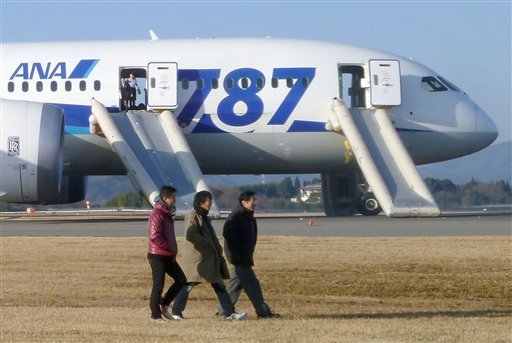The federal government grounded Boeing’s newest and most technologically advanced jetliner Wednesday, declaring that the 787 cannot fly again until the risk of battery fires is addressed.
The Federal Aviation Administration said it would work with Boeing and U.S. airlines to develop a plan to allow the Dreamliner to “resume operations as quickly and safely as possible.” United Airlines is the only U.S. carrier with 787s. It has six.
The FAA decision was the latest setback for a plane that was supposed to set a new standard for jet travel but has been beset by one mishap after another.
For the second time in two weeks, a smoking or burning battery has been tied to an emergency aboard a 787. Almost half of the 787s that have been delivered have now been grounded for safety checks. And the latest incident raises the risk that the jet’s electrical problems are more dangerous than previously thought.
So far, no one has suggested that the plane’s fundamental design can’t be fixed. But it’s unclear how much will need to be changed.
The remedy could range from relatively quick-and-easy improvements to more extensive changes that could delay deliveries just as Boeing is trying to speed production up from five planes per month to 10.
On Wednesday, Japan’s All Nippon Airways said pilots smelled something burning and received a cockpit message warning of battery problems while flying from Yamaguchi Ube airport in western Japan to Tokyo.
They made an emergency landing at Takamatsu airport in western Japan, and passengers evacuated using inflatable slides.
An inspection found that a flammable liquid had leaked from the main lithium-ion battery, which is below and slightly behind the cockpit. Investigators found burn marks around the damage.
“Anytime you have a fire on board — whether it’s the battery that has caused it or a passenger that caused it or another electrical component — that’s a very a serious situation on an aircraft and something not to be taken lightly,” said Kevin Hiatt, president of the Flight Safety Foundation.
Japan’s Kyodo News agency quoted transport ministry investigator Hideyo Kosugi as saying that the liquid leaked through the electrical room floor to the outside of the aircraft.
The transport ministry said the leak could have led to an accident. ANA, which operates 17 of the jets, and Japan Airlines, which has seven, said they won’t fly their 787s until they complete safety checks. That’s almost half of the 50 planes Boeing has delivered since handing the first one over to ANA in late 2011.
Just last week, a battery on a Japan Airlines 787 caught fire soon after the plane landed at Boston’s Logan Airport. It took firefighters 40 minutes to put out the flames.
The 787 is the first plane to make extensive use of lithium-ion batteries, which have raised concerns in the past for their potential to catch fire. The Federal Aviation Administration has given the batteries extra scrutiny and issued a special rule for their use in the 787. The plane has two batteries — the main one near the front and a second one in the rear.
Boeing and the airlines will need to move quickly to determine whether the problem is a flaw in the batteries themselves, in the plane’s wiring or in some other area that’s fundamental to the plane’s electrical system.
